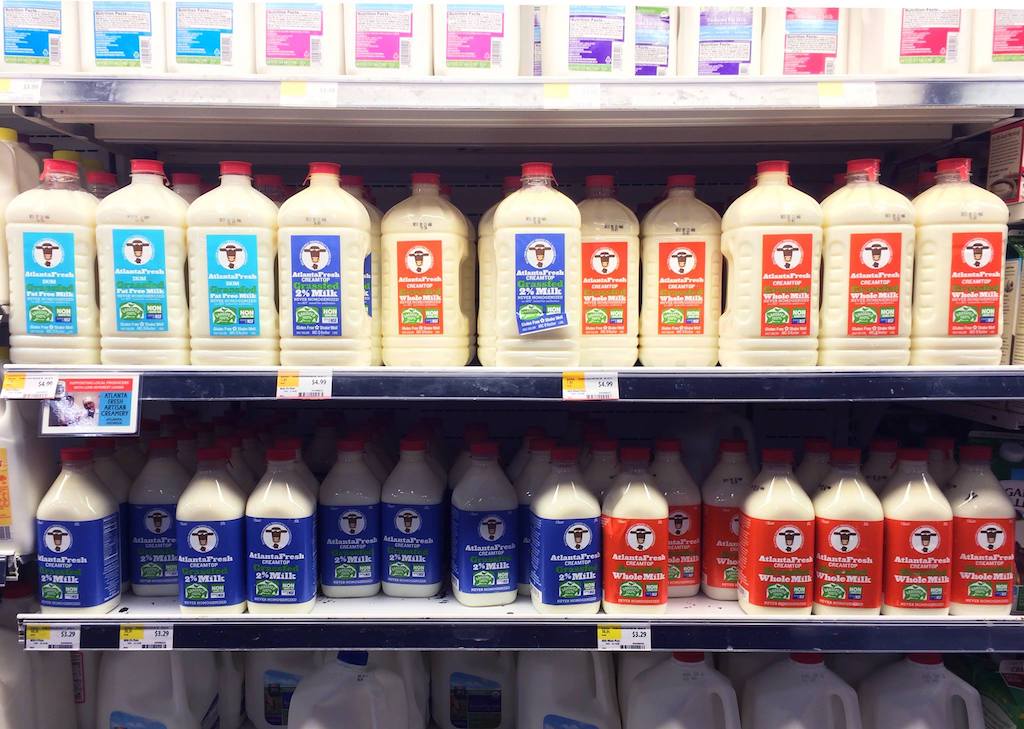New Food Economy: This creamery took on millions in debt for a contract with Whole Foods. Then Whole Foods bailed
by Joe Fassler | March 8th, 2018
It’s an all-too-familiar story, with no easy villain.
It’s never easy losing a business. But the painful thing about AtlantaFresh Artisan Creamery’s story is how far it fell, and how fast. When I call Ron Marks, who founded the line of grass-based dairy products almost a decade ago, his voice is hoarse with grief. “If I told you things were going well, I’d be lying to you,” he says. Two years ago, he was running a multi-million dollar company with over 30 product lines, which were sold at Whole Foods Market locations all over the country. But last week, Marks laid off all 32 employees at his headquarters in Norcross, Georgia, where his 12,000-square-foot processing facility now sits empty.
Last Friday, Marks posted a press release on the company website with the news, and started the process of dismantling everything he’d built.
Whole Foods, which had been AtlantaFresh’s main customer for over a decade, turned out to be both generous patron and cruel master—an industry power broker that helped vault AtlantaFresh from regional specialty to national brand, and ultimately helped ensure its demise. But the dairy’s ruin probably wasn’t about Marks’s product, its pricing, or our appetite for grass-fed milk. It was a matter of bad timing: Whole Foods is undergoing a major shift in its corporate culture, as it moves its sourcing away from regional suppliers and starts focusing more on a centralized purchasing model.
 AtlantaFresh is just another small company that became collateral damage in a retail giant’s transformation.
AtlantaFresh is just another small company that became collateral damage in a retail giant’s transformation.
Marks founded AtlantaFresh in 2009, making hand-packed mozzarella and greek yogurt products at its facility in Norcross. It was only a few months before Whole Foods took notice. By December of that year, the grocer was stocking AtlantaFresh in stores in its “South Region,” one of 11 regions nationwide that the company treated as small empires, each with its own selection of locally-sourced speciality goods. “We were ecstatic,” Marks says. Over the next years, Whole Foods’ work with AtlantaFresh was typical of the nurturing, hands-on approach it famously took with small food businesses.
In 2011, the retailer gave the company a $150,000 loan so that the dairy could upgrade to a federally inspected plant and start selling product across state lines. Eventually, Marks was selling at 180 Whole Foods locations across the country, about half of the entire Whole Foods system; the retailer’s sales made up about 60 percent of AtlantaFresh’s business. From the beginning it was “a very positive, supportive relationship,” he tells me.
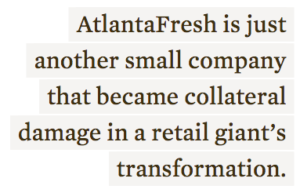 “During the nine years that we did business with them,” Marks says, “it was amazing to me how much autonomy regional buyers and even store-level buyers had to bring in local products and make deals with small, local producers.”
“During the nine years that we did business with them,” Marks says, “it was amazing to me how much autonomy regional buyers and even store-level buyers had to bring in local products and make deals with small, local producers.”
AtlantaFresh’s defining moment—and finally, its undoing—came in June 2015. A Whole Foods representative approached Marks at a trade show, he says, and mentioned that the company was very interested in getting more grass-fed, certified non-GMO milk on the shelves. “You think you could supply that to us?” Marks remembers him asking.
It was a treasured opportunity, but it was also 2016 where the trouble started.
At the time, Marks was working with a local farmer, Richard Watson of Newberry Farm in Waynesboro, Georgia, who’d changed his conventional dairy over to a herd of 700 fully grass-fed cows. Marks would have needed to dramatically upgrade his facility if he was going to supply Whole Foods at scale, but he and Watson determined that it would be financially feasible if the grocer could provide a sizable guaranteed purchase order: 30,000 gallons of milk per week.
Whole Foods agreed to commit to that volume, and ultimately awarded AtlantaFresh a seven-year contract that Marks says was worth $100 million—more than $15 million at wholesale price each year. It was going to be a major investment, and it would have meant that Whole Foods suddenly swallowed up a huge proportion of AtlantaFresh’s sales (about 90 percent). But it would also have taken the company from about $2 million in annual revenue, Marks figured, to more than seven times that.
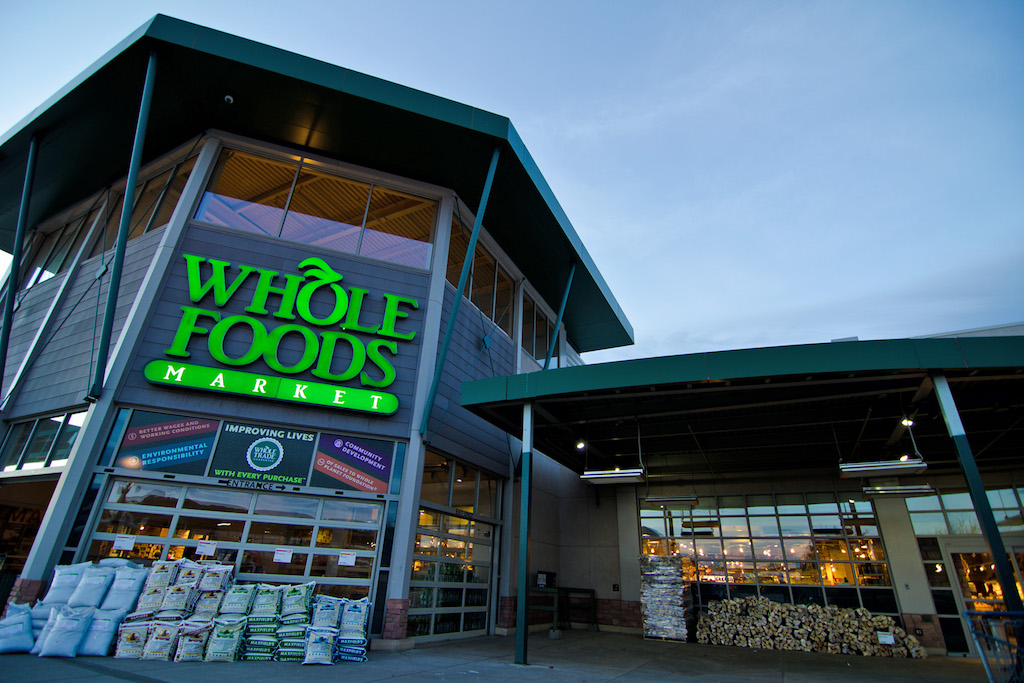
Photo courtesy of Whole Foods
Whole Foods is undergoing a major shift in its corporate culture, as it moves its sourcing away from regional suppliers and starts focusing more on a centralized purchasing model
He decided the risk was worth it. “At times, I really thought, ‘Gee, does it really make sense to take on this much debt?,’” he tells me. “But given my history with my partner at Whole Foods and the amount of money it represented, it seemed like a sure bet.”
It took about a year to build the fresh milk program. AtlantaFresh had to completely revamp its facility, putting in industrial-scale pasteurizing equipment and a bottling line. Whole Foods gave the company a $500,000 loan, and Marks took out another $2 million in loans to finance the rest.
But as the facility was being built, Whole Foods was undergoing changes of its own. In February of 2016, The Wall Street Journal reported that the company was going to start “whittling away” at the autonomy it had long provided to its stores; in April, at the Natural Products Expo West trade show, Whole Foods’ global vice president of purchasing told a packed conference room of food entrepreneurs that the company was going to start doing business more like a normal grocery store, taking a more national approach to its suppliers.
It’s hard to say whether that shift away from local suppliers doomed the AtlantaFresh milk program. But by the time Marks made his first product shipment, in July 2016, Whole Foods’ enthusiasm seemed to him to have waned.
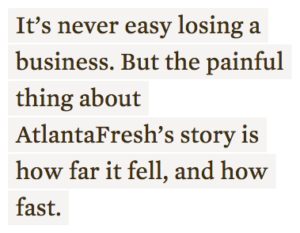 According to Marks, Whole Foods never bought the 30,000 weekly gallons of milk it promised, even though AtlantaFresh had gone deeply into debt to build a facility that could process that amount and more. From the start, the retailer only bought 10,000 gallons per week, one-third of its commitment. Marks also says that Whole Foods didn’t honor its agreement in terms of promotion efforts it had promised. Aside from some initial advertising and demoing in the South Region, he says, Whole Foods didn’t support the product.
According to Marks, Whole Foods never bought the 30,000 weekly gallons of milk it promised, even though AtlantaFresh had gone deeply into debt to build a facility that could process that amount and more. From the start, the retailer only bought 10,000 gallons per week, one-third of its commitment. Marks also says that Whole Foods didn’t honor its agreement in terms of promotion efforts it had promised. Aside from some initial advertising and demoing in the South Region, he says, Whole Foods didn’t support the product.
“They certainly have the expertise to be able to know how to launch and market and promote and manage the logistics of a shelf-life fresh milk program,” Marks says. “But they just didn’t do it. From day one, they just had no plan to move the quantity of milk they had committed to.”
Marks says issues emerged with distribution, too. AtlantaFresh’s cream-top, non-homogenized milk may have been a premium product, but it also had a shorter shelf life than the “ultra-pasteurized” products: just 28 days. That short span ended up being an issue with Whole Foods’ primary distributor, United Natural Foods, Inc. (UNFI). Marks claims that AtlantaFresh did everything to expedite its shipments to the distributor, only to have the product sit on its shelves.
The milk “would go into what we came to view as the UNFI ‘cave-aging’ system, with a 25-day shelf life,” he says, ”and then it would show up in Whole Foods with a five- to seven-day shelf life left on it.”
The shelf-life issue probably contributed to the lack of sales—Marks says half the product Whole Foods bought was “shrinking out,” or was left unsold.
 “By the third or fourth month of the program everybody knew it was in trouble,” he says. “But instead of trying to find ways to drive the volume and and a follow up on the commitments they had made, [Whole Foods] kept trying to minimize their commitments.”
“By the third or fourth month of the program everybody knew it was in trouble,” he says. “But instead of trying to find ways to drive the volume and and a follow up on the commitments they had made, [Whole Foods] kept trying to minimize their commitments.”
In August 2017, Marks says, Whole Foods’s CFO called to tell him the company was likely to cancel the contract. The official notification came in September. It was a blow, but not all was lost: Marks says that Stephen Corradini, Whole Foods’s vice president of purchasing for the South region, told him that the product would continue to be sold on its home turf. Marks hoped that would be enough volume to net the company $4.5 million each year—enough to break even, and find some other customers to pick up the slack. (Corradini did not return a request for comment by press time.)
But in September, Marks says, Corradini—who had helped broker the partnership in the first place, and had been a long-term advocate for AtlantaFresh—parted ways with Whole Foods. And, by October, it became clear that even Whole Foods locations in the Atlanta area would not carry any of Marks’s more than 30 products.
“They canceled every one of them, and they never notified us directly,” Marks says. “We had to find out through the distributor. Pardon my French, but I couldn’t believe how shitty and how petty that was, that they didn’t have the courtesy to let us know directly.”
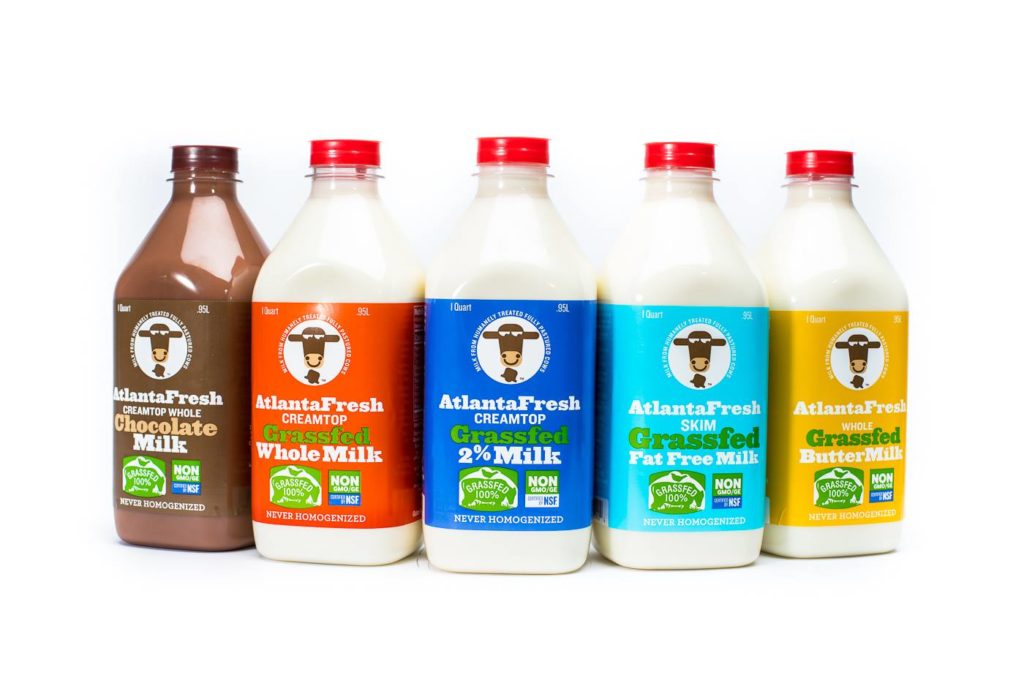
Courtesy of AtlantaFresh
From the start, Whole Foods only bought 10,000 gallons per week, one-third of its commitment to AtlantaFresh
“We are always excited to bring new local products to our stores and customers, but, unfortunately, not all products meet sales expectations,” a Whole Foods Market spokesperson told me by email. “When that occurs, we have ongoing conversations with the supplier to try to improve sales. In this case, we also made significant efforts across the business to increase sales, including in-store marketing, paid advertising, special promotions and expanded distribution. Despite our efforts, we are not always able to raise demand and we must occasionally make the difficult decision to discontinue products.”
For Marks, that meant that after only 14 months, it was all over. He was sitting on a 12,000-foot facility that could bottle 40,000 gallons of milk each week, with no customers and millions of dollars in debt. Since then, he and Watson did everything they could to stay alive. Two other grocery chains, Publix and Kroger, expressed interest in carrying the products, but the onboarding program would have taken six months to a year. Marks couldn’t afford to lose money month after month while he waited to get into other large grocers’ systems.
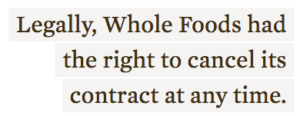 But the most difficult consideration is yet to come: what to do about all the mounting bills and a factory that must still be paid for while it sits empty.
But the most difficult consideration is yet to come: what to do about all the mounting bills and a factory that must still be paid for while it sits empty.
“I owe a lot of people a lot of money,” Marks says. “I’m trying to stay out of bankruptcy, both business and personal.”
 Whole Foods did forgive its $500,000 loan, which Marks appreciates. But that money is all tied up in milk processing equipment, and won’t offset the millions still owed on the facility. He’s sent Whole Foods an invoice for $15 million, the value of the product guaranteed, but never actually purchased, over the course of the 14 months. He’s seeking a mediation settlement from his former customer, but isn’t sure what options he’ll have left if negotiations fall through. Legally, Whole Foods had the right to cancel its contract at any time. Some lawyers have suggested Marks may have a case, at least regarding the product that was never purchased. But Marks says he is wary of wrangling legally with a company—whose parent company is owned by the world’s richest man—that has bottomless resources and can afford endless appeals.
Whole Foods did forgive its $500,000 loan, which Marks appreciates. But that money is all tied up in milk processing equipment, and won’t offset the millions still owed on the facility. He’s sent Whole Foods an invoice for $15 million, the value of the product guaranteed, but never actually purchased, over the course of the 14 months. He’s seeking a mediation settlement from his former customer, but isn’t sure what options he’ll have left if negotiations fall through. Legally, Whole Foods had the right to cancel its contract at any time. Some lawyers have suggested Marks may have a case, at least regarding the product that was never purchased. But Marks says he is wary of wrangling legally with a company—whose parent company is owned by the world’s richest man—that has bottomless resources and can afford endless appeals.
For now, Marks is stuck with an empty facility, a sense of what might have been, and a hard-luck personal story that could offer cautionary lessons to students in Business 101: Don’t cater too much to the needs of any one customer, and don’t bet your business on a contract that can be canceled at any time.
This painful story is also a familiar one. For much of its history, Whole Foods has been a crucial stepping stone for smaller food businesses, one that provided a platform when no one else would. The welcoming attitude, powerful brand, and well-heeled customer base can prove irresistible for entrepreneurs, and AtlantaFresh is not the first company to make ill-advised decisions after falling under the company’s spell.
A Facebook post announcing the company’s closure generated hundreds of comments online, with former customers venting their disbelief, expressing outrage, and offering advice.
“I hated yogurt my whole life until I tried yours, and fell in love,” one customer wrote. “I guess I have to go back to hating yogurt. And Whole Foods.”
